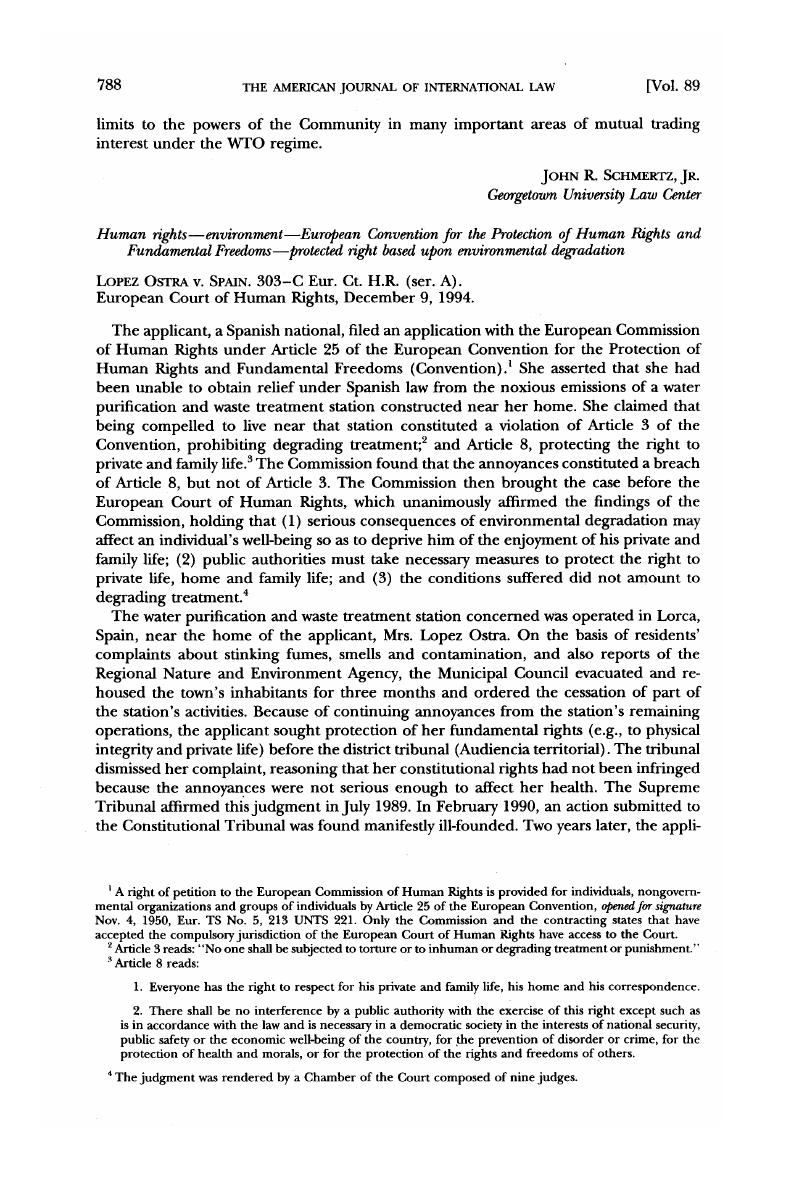Published online by Cambridge University Press: 27 February 2017

1 A right of petition to the European Commission of Human Rights is provided for individuals, nongovernmental organizations and groups of individuals by Article 25 of the European Convention, opened for signature Nov. 4, 1950, Eur. TS No. 5, 213 UNTS 221. Only the Commission and the contracting states that have accepted the compulsory jurisdiction of the European Court of Human Rights have access to the Court.
2 Article 3 reads: “No one shall be subjected to torture or to inhuman or degrading treatment or punishment.”
3 Article 8 reads:
1. Everyone has the right to respect for his private and family life, his home and his correspondence.
2. There shall be no interference by a public authority with the exercise of this right except such as is in accordance with the law and is necessary in a democratic society in the interests of national security, public safety or the economic well-being of the country, for the prevention of disorder or crime, for the protection of health and morals, or for the protection of the rights and freedoms of others.
4 The judgment was rendered by a Chamber of the Court composed of nine judges.
5 Article 25 states that the applicant must be a “victim of a violation of [his] rights” to have standing. See generally Henri Delvaux, La Notion de victims au sens de l’article 25 de la Convention européenne des droits de l’homme, in ACTES DU CINQUIÈME COLLOQUE SUR LA CONVENTION EUROPÉENNE DES DROITS DE L’HOMME 35 (1982); Kersten Rogge, The ‘Victim’ Requirement in Article 25 of the European Convention on Human Rights, in PROTECTING HUMAN RIGHTS: THE EUROPEAN DIMENSION: STUDIES IN HONOR OF G. WIARDA 539 (Franz Matscher & Herbert Petzold eds., 1988).
6 Guzzardi v. Italy, 39 Eur. Ct. H.R. (ser. A), para. 72 (1980).
7 172 Eur. Ct. H.R. (ser. A) (1990).
8 S. v. France, App. No. 13728/88 (May 17,1990), reprinted in 3 REVUE UNIVERSELLE DES DROITS DE L’HOMME 236 (1991).
9 303-C Eur. Ct. H.R. (ser. A), para. 51.
10 On Article 8, see generally ANDREW DRZEMCZEWSKI, LE DROIT AU RESPECT DE LA VIE PRIVÉE ET FAMILIALE, DU DOMICILE ET DE LA CORRESPONDANCE TEL QUE LE GARANTIT L’ARTICLE 8 DE LA CONVENTION EUROPEENNE DES DROITS DE L’HOMME (1985); Alpha M. Connelly, Problems of Interpretation of Article 8 of the European Convention on Human Rights, 35 INT’L & COMP. L.Q. 567 (1986); Jan de Meyer, The Right to Respect for Private Life and Family Life, Home and Communications in Relations Between Individuals, and the Resulting Obligations for State Parties to the Convention, in PRIVACY AND HUMAN RIGHTS 267 (Arthur H. Robertson ed., 1973); Louise Doswald-Beck, The Meaning of the Right to Respect for Private Life under the European Convention on Human Rights, 4 HUM. RTS. L.J. 283 (1983); Dimitrios Evrigenis, Recent Case-Law of the European Court of Human Rights on Articles 8 and 10 of the European Convention on Human Rights, 3 HUM. RTS. L.J. 121 (1982); Caroline J. Forder, Legal Protection under Article 8 ECHR: Marckx and Beyond, 37 NETH. INT’L L.J. 162 (1990).
11 172 Eur. Ct. H.R. (ser. A), paras. 38–40 (1990).
12 Marckx v. Belgium, 31 Eur. Ct. H.R. (ser. A), para. 31 (1979); Airey v. Ireland, 32 Eur. Ct. H.R. (ser. A), para. 33 (1979); X. and Y. v. Netherlands, 91 Eur. Ct. H.R. (ser. A), para. 23 (1985).
13 Powell and Rayner, 172 Eur. Ct. H.R. (ser. A), para. 41 (1990).
14 Forder, supra note 10, at 176–78.
15 In Abdulaziz, Cabales and Balkandali v. United Kingdom, 94 Eur. Ct. H.R. (ser. A), para. 67 (1985), the Court stated:
especially as far as those positive obligations are concerned, the notion of “respect” is not clear-cut: having regard to the diversity of the practices followed and the situations obtaining in the Contracting States, the notion’s requirements will vary considerably from case to case. Accordingly, this is an area in which the Contracting Parties enjoy a wide margin of appreciation in determining the steps to be taken to ensure compliance with the Convention with due regard to the needs and resources of the community and of the individuals.
See also Rees v. United Kingdom, 106 Eur. Ct. H.R. (ser. A), para. 37 (1986).
16 172 Eur. Ct. H.R. (ser. A) (1990).
17 June 14, 1992, UN Doc. A/CONF.151/5/Rev.l, Principle 10 (1992), reprinted in 31 ILM 874, 878 (1992).